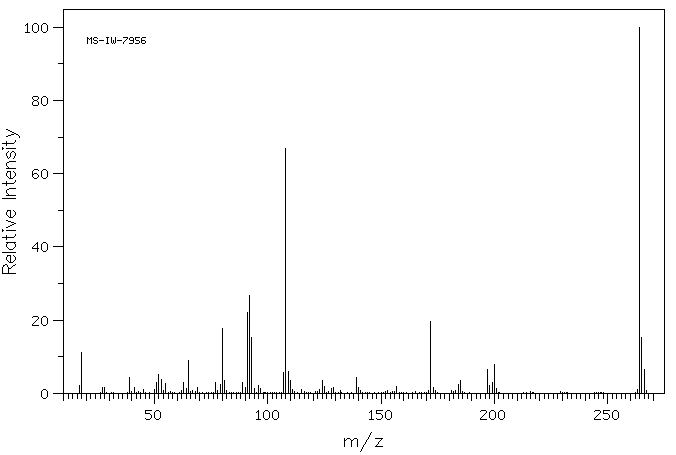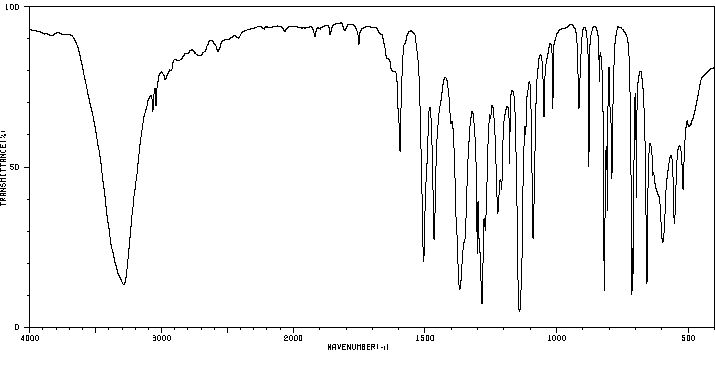2-甲基-5-(苯磺酰基)-1,4-苯二酚 | 30958-16-8
中文名称
2-甲基-5-(苯磺酰基)-1,4-苯二酚
中文别名
——
英文名称
2-Tosylhydroquinone
英文别名
2-tosylbenzene-1,4-diol;2',5'-Dihydroxy-4-methyl-diphenyl-sulfon;2-(toluene-4-sulfonyl)-benzene-1,4-diol;2-(4-methylphenyl)sulfonylbenzene-1,4-diol
CAS
30958-16-8
化学式
C13H12O4S
mdl
——
分子量
264.302
InChiKey
JDVLOEPBUIGUKP-UHFFFAOYSA-N
BEILSTEIN
——
EINECS
——
-
物化性质
-
计算性质
-
ADMET
-
安全信息
-
SDS
-
制备方法与用途
-
上下游信息
-
文献信息
-
表征谱图
-
同类化合物
-
相关功能分类
-
相关结构分类
计算性质
-
辛醇/水分配系数(LogP):2.3
-
重原子数:18
-
可旋转键数:2
-
环数:2.0
-
sp3杂化的碳原子比例:0.08
-
拓扑面积:83
-
氢给体数:2
-
氢受体数:4
安全信息
-
海关编码:2907299090
SDS
反应信息
-
作为反应物:描述:1,2-二甲基吲哚 、 2-甲基-5-(苯磺酰基)-1,4-苯二酚 以 aq. phosphate buffer 、 乙腈 为溶剂, 以77%的产率得到2-(1,2-dimethyl-1H-indol-3-yl)-5-tosylcyclohexa-2,5-diene-1,4-dione参考文献:名称:新型单和双取代氢醌和苯醌电化学合成的不同策略摘要:在两个连续的氧化步骤中进行了2-吲哚基-5-芳基磺酰基-对苯醌衍生物的电化学合成。首先涉及在芳基亚磺酸作为亲核试剂的存在下对苯二酚,4-(哌嗪-1-基)苯酚)和1-(4-(4-羟基苯基)哌嗪-1-基)乙酮的氧化。我们的伏安数据表明,电化学生成的对苯醌与芳基亚磺酸参与迈克尔加成反应,生成2-(芳基磺酰基)苯-1,4-二醇。第二个步骤是在1,2-二甲基吲哚存在下氧化2-(芳基磺酰基)苯-1,4-二醇和形成2-吲哚基-5-芳基磺酰基-p-苯醌衍生物作为最终产物。还提出了合成2-吲哚基-5-芳基磺酰基-对苯醌衍生物的可能机理。DOI:10.1016/j.electacta.2014.09.122
-
作为产物:描述:2-(toluene-4-sulfonyl)-[1,4]benzoquinone 在 sodium tetrahydroborate 作用下, 以 甲醇 为溶剂, 以90%的产率得到2-甲基-5-(苯磺酰基)-1,4-苯二酚参考文献:名称:醌与磺酰氯的Ir催化的C–S偶联摘要:摘要已开发出一种简洁有效的方法,可通过Ir催化的醌与磺酰氯的C–S偶联来制备磺酰醌和磺酰1,,4-二醇。因此,该方法论证明了其作为广泛的磺酰基醌的通用合成工具的价值,可产生良好或优异的收率。 图形概要DOI:10.1007/s13738-016-0897-8
文献信息
-
Hydroxysulfonylation of Quinones with Aryl(alkyl)sulfonyl Hydrazides for the Synthesis of 1,4-Dihydroxy-2-aryl(alkyl)sulfonylbenzenes作者:Ping-Gui Li、Yan-Chun Li、Tao Zhu、Liang-Hua Zou、Zhimeng WuDOI:10.1002/ejoc.201701199日期:2017.11.2A copper-catalyzed procedure for the direct synthesis of 1,4-dihydroxy-2-phenylsufonylbenzenes is presented starting from simple quinones and sulfonyl hydrazides. A series of biologically useful FabH inhibitors are obtained in good yields. Both aryl and alkyl substituents are well tolerated in the reaction.
-
一种磺酰基氢醌类化合物的制备方法
-
One-pot access to sulfonylated naphthalenediols/hydroquinones from naphthols/phenols with sodium sulfinates in an aqueous medium作者:Lingxin Meng、Ruike Zhang、Yuqiu Guan、Tian Chen、Zhiqiang Ding、Gongshu Wang、Aikebaier Reheman、Zhangpei Chen、Jianshe HuDOI:10.1039/d0nj05285j日期:——aqueous medium has been developed with up to 97% yield. The whole reaction requiring no transition-metal catalysts could proceed smoothly with hypervalent iodine compounds as the oxidant. Both naphthols and phenols were viable with inexpensive and readily available sodium sulfinates as the sulfonylation reagents under an ambient atmosphere. This procedure is scalable, and the products could be easily obtained
-
Ionic Liquids-Promoted Addition of Arylsulfinic Acids to <i>p</i>-Quinones: A Green Synthesis of Diaryl Sulfones作者:J. Yadav、B. Reddy、T. Swamy、N. RamireddyDOI:10.1055/s-2004-829145日期:——Arylsulfinic acids undergo smooth conjugate addition to p-quinones in air- and moisture-stable second generation room temperature ionic liquid [bmim]BF 4 under mild conditions to produce the corresponding arylsulfonylhydroquinones in excellent yields with high selectivity. In this reaction, ionic liquid plays the dual role as the solvent and the catalyst. The quinones show enhanced reactivity in ionic
-
Reactions of the free toluene-p-sulphonyl radical. Part I. Diagnostic reactions of free radicals作者:C. M. M. da Silva Corrêa、William A. WatersDOI:10.1039/j39680001874日期:——The free p·CH3·C6H4·SO2 radical is easily produced by the thermolysis or photolysis of p·Me·C6H4·SO2·l; copper powder assists the removal of iodine and so do radicals R2C(CN)·. Evidence is presented to show that p·Me·C6H4·SO2·l adds homolytically to olefins and that free p·Me·C6H4·SO2· radicals tend to disproportionate according to the equation: 6 Me·C6H4·SO2·→ 2(Me·C6H4·SO2)2O + Me·C6H4·S·SO2·C6H4·Mep ·Me·C 6 H 4 ·SO 2 ·l的热解或光解容易产生游离的p ·CH 3 ·C 6 H 4 ·SO 2自由基;铜粉有助于去除碘,自由基R 2 C(CN)·也是如此。证据表明,p ·Me·C 6 H 4 ·SO 2 ·l向烯烃均溶,并且游离的p ·Me·C 6 H 4 ·SO 2 ·自由基根据以下方程式趋于歧化:6 Me· C 6H 4 ·SO 2 · → 2(Me·C 6 H 4 ·SO 2)2 O + Me·C 6 H 4 ·S·SO 2 ·C 6 H 4 ·Me p ·Me·C 6 H 4 ·SO 2 ·自由基添加醌给予ditoluene-的氧原子p quinols的-磺酸盐酯。芳基亚磺酰基基团似乎不具有类似的反应性。它们仅二聚为硫代磺酸酯Ar·S·SO 2 ·Ar。
表征谱图
-
氢谱1HNMR
-
质谱MS
-
碳谱13CNMR
-
红外IR
-
拉曼Raman
-
峰位数据
-
峰位匹配
-
表征信息
同类化合物
(βS)-β-氨基-4-(4-羟基苯氧基)-3,5-二碘苯甲丙醇
(S,S)-邻甲苯基-DIPAMP
(S)-(-)-7'-〔4(S)-(苄基)恶唑-2-基]-7-二(3,5-二-叔丁基苯基)膦基-2,2',3,3'-四氢-1,1-螺二氢茚
(S)-盐酸沙丁胺醇
(S)-3-(叔丁基)-4-(2,6-二甲氧基苯基)-2,3-二氢苯并[d][1,3]氧磷杂环戊二烯
(S)-2,2'-双[双(3,5-三氟甲基苯基)膦基]-4,4',6,6'-四甲氧基联苯
(S)-1-[3,5-双(三氟甲基)苯基]-3-[1-(二甲基氨基)-3-甲基丁烷-2-基]硫脲
(R)富马酸托特罗定
(R)-(-)-盐酸尼古地平
(R)-(-)-4,12-双(二苯基膦基)[2.2]对环芳烷(1,5环辛二烯)铑(I)四氟硼酸盐
(R)-(+)-7-双(3,5-二叔丁基苯基)膦基7''-[((6-甲基吡啶-2-基甲基)氨基]-2,2'',3,3''-四氢-1,1''-螺双茚满
(R)-(+)-7-双(3,5-二叔丁基苯基)膦基7''-[(4-叔丁基吡啶-2-基甲基)氨基]-2,2'',3,3''-四氢-1,1''-螺双茚满
(R)-(+)-7-双(3,5-二叔丁基苯基)膦基7''-[(3-甲基吡啶-2-基甲基)氨基]-2,2'',3,3''-四氢-1,1''-螺双茚满
(R)-(+)-4,7-双(3,5-二-叔丁基苯基)膦基-7“-[(吡啶-2-基甲基)氨基]-2,2”,3,3'-四氢1,1'-螺二茚满
(R)-3-(叔丁基)-4-(2,6-二苯氧基苯基)-2,3-二氢苯并[d][1,3]氧杂磷杂环戊烯
(R)-2-[((二苯基膦基)甲基]吡咯烷
(R)-1-[3,5-双(三氟甲基)苯基]-3-[1-(二甲基氨基)-3-甲基丁烷-2-基]硫脲
(N-(4-甲氧基苯基)-N-甲基-3-(1-哌啶基)丙-2-烯酰胺)
(5-溴-2-羟基苯基)-4-氯苯甲酮
(5-溴-2-氯苯基)(4-羟基苯基)甲酮
(5-氧代-3-苯基-2,5-二氢-1,2,3,4-oxatriazol-3-鎓)
(4S,5R)-4-甲基-5-苯基-1,2,3-氧代噻唑烷-2,2-二氧化物-3-羧酸叔丁酯
(4S,4''S)-2,2''-亚环戊基双[4,5-二氢-4-(苯甲基)恶唑]
(4-溴苯基)-[2-氟-4-[6-[甲基(丙-2-烯基)氨基]己氧基]苯基]甲酮
(4-丁氧基苯甲基)三苯基溴化磷
(3aR,8aR)-(-)-4,4,8,8-四(3,5-二甲基苯基)四氢-2,2-二甲基-6-苯基-1,3-二氧戊环[4,5-e]二恶唑磷
(3aR,6aS)-5-氧代六氢环戊基[c]吡咯-2(1H)-羧酸酯
(2Z)-3-[[(4-氯苯基)氨基]-2-氰基丙烯酸乙酯
(2S,3S,5S)-5-(叔丁氧基甲酰氨基)-2-(N-5-噻唑基-甲氧羰基)氨基-1,6-二苯基-3-羟基己烷
(2S,2''S,3S,3''S)-3,3''-二叔丁基-4,4''-双(2,6-二甲氧基苯基)-2,2'',3,3''-四氢-2,2''-联苯并[d][1,3]氧杂磷杂戊环
(2S)-(-)-2-{[[[[3,5-双(氟代甲基)苯基]氨基]硫代甲基]氨基}-N-(二苯基甲基)-N,3,3-三甲基丁酰胺
(2S)-2-[[[[[((1S,2S)-2-氨基环己基]氨基]硫代甲基]氨基]-N-(二苯甲基)-N,3,3-三甲基丁酰胺
(2S)-2-[[[[[[((1R,2R)-2-氨基环己基]氨基]硫代甲基]氨基]-N-(二苯甲基)-N,3,3-三甲基丁酰胺
(2-硝基苯基)磷酸三酰胺
(2,6-二氯苯基)乙酰氯
(2,3-二甲氧基-5-甲基苯基)硼酸
(1S,2S,3S,5S)-5-叠氮基-3-(苯基甲氧基)-2-[(苯基甲氧基)甲基]环戊醇
(1S,2S,3R,5R)-2-(苄氧基)甲基-6-氧杂双环[3.1.0]己-3-醇
(1-(4-氟苯基)环丙基)甲胺盐酸盐
(1-(3-溴苯基)环丁基)甲胺盐酸盐
(1-(2-氯苯基)环丁基)甲胺盐酸盐
(1-(2-氟苯基)环丙基)甲胺盐酸盐
(1-(2,6-二氟苯基)环丙基)甲胺盐酸盐
(-)-去甲基西布曲明
龙蒿油
龙胆酸钠
龙胆酸叔丁酯
龙胆酸
龙胆紫-d6
龙胆紫








